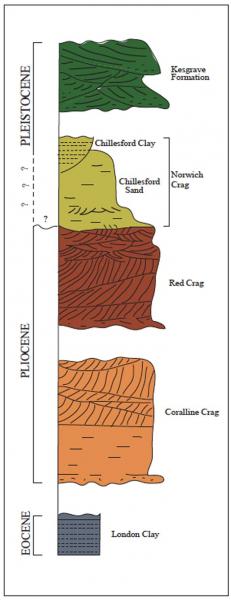Adapted from Daley and Balson, 1999.
 Figure. Schematic sequence (not to scale) of the Crag formations in Suffolk and north Essex
Figure. Schematic sequence (not to scale) of the Crag formations in Suffolk and north Essex
The ‘crag-formation’ of East Anglia was regarded as a single deposit of uniform age until 1835 when Charlesworth realised that several distinct formations could be recognised by their fossil contents, and that these formations represented distinct time intervals. Based on the study of exposures at Ramsholt, he identified two formations for which he coined the names Coralline Crag and Red Crag. The Coralline Crag was so named on account of its large abundance of ‘corallines’, the great majority of which are in fact bryozoans, whereas the Red Crag was named for the colour of these mollusc-rich shelly sands. Subsequently, in 1837 Charlesworth identified another formation, which he named the Mammiliferous Crag. This later became known as the Norwich Crag (Lyell 1839). All three deposits - Coralline, Red and Norwich Crags – are now afforded formation status.
Inferences of palaeoclimate from the East Anglian Crags have been crucial in establishing the stratigraphical terminology and sequence of the British Neogene. After the division of the Crag into its three formations, Forbes studied Crag molluscs and compared their distribution with that of living species, concluding that a progressive cooling of the environment had taken place through time, from the Coralline Crag through the Red Crag to the Norwich Crag, culminating in the commencement of glaciation in the British Isles.
For more information on the three Crag formations, follow the links below.